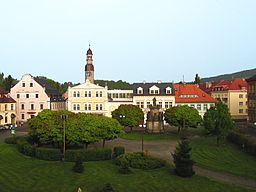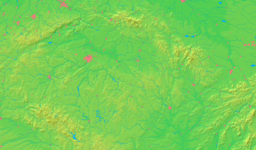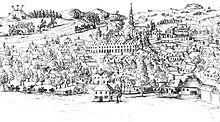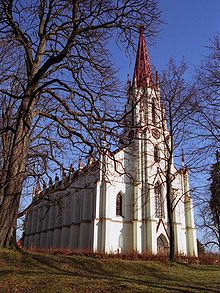- Chrastava
-
Chrastava Town Town HallFlagCoat of armsCountry Czech Republic Region Liberec District Liberec Commune Liberec Municipality Chrastava Elevation 295 m (968 ft) Coordinates 50°49′1″N 14°58′8″E / 50.81694°N 14.96889°E Area 27.46 km2 (10.6 sq mi) Population 5,976 Density 218 / km2 (565 / sq mi) First mentioned 1352 Mayor Michael Canov Timezone CET (UTC+1) - summer (DST) CEST (UTC+2) Postal code 463 31 Wikimedia Commons: Chrastava Statistics: statnisprava.cz Website: www.chrastava.cz Chrastava (Czech pronunciation: [ˈxrastava]; German: Kratzau) is a town in northern Bohemia in the Czech Republic about 10 kilometre (6 mi) northwest of the regional capital Liberec. The town is situated on the Jeřice brook near to its confluence with the Lusatian Neisse (Czech: Lužická Nisa). Chrastava is surrounded by hills of the Ještěd Mountains and more distant Jizera Mountains.
Contents
History of the town of Chrastava
The town of Chrastava was first mentioned in 1351 as Craczauia. It was founded very probably in the end of 13th century on the site of an older village of the West Slavic Milceni tribe by German settlers, having been invited by King Ottokar II of Bohemia. They came mainly from the city Pirna in Saxony.
Chrastava, then known mostly by the German name Kratzau, was occupied by the Hussites who use the town as a base for expeditions into Lusatia during the Hussite Wars. Kratzau was governed by the Habsburg Monarchy after Bohemia was inherited by the Austrian Habsburgs in 1526. It received town rights in 1527.
The town became a mining centre in 15th and 16th century, in particularly in copper, tin, lead, zinc, iron and silver mining. Two small mining towns, Andělská Hora (German: Engelsberg) and Panenská Hůrka (German: Frauenberg), were established by the miners more closely to the metal veins.
After the mines were abandoned, many of the people were forced to find a new kind of livelihood. Therefore they started to produce cloth on a loom in many houses in the town. During the 19th century the handicraft industry succumbed to mass production by many textile manufactures that had been built in the town. During the second half of the 19th century Kratzau became famous also for its production of organs and other musical instruments which were exported abroad (e.g. Gebrüder Riemer Kratzau company).
Kratzau became part of Czechoslovakia after the collapse of Austria-Hungary from World War I and was officially renamed Chrastava. The town was almost entirely ethnic German, however, and was ceded to Nazi Germany along with the rest of the Sudetenland after the Munich Agreement in 1938.
During World War II an ammunition factory was founded in Chrastava which produced hand grenades and other military material for the armed forces of Germany. A subcamp of the Gross-Rosen concentration camp was set up near the factory for Jewish women, who were exploited for forced labour.
After the violent deportation and expulsion of Germans after World War II in 1945-1947, Chrastava was resettled mainly by Czechs, along with Slovaks, Roma gipsies, and other nationalities.
Historical population
Population development of the town of Chrastava Year Population Czechs (%) Germans (%) Other (%) 1737 1,061 - - - 1860 2,960 - - - 1933 4,640 15 85 - 1945 7,056 4 75 21 1948 2,818 86 6 8 2001 5,944 93 1 6 Subdivisions
Chrastava consists of four main town sections and two villages:
- Chrastava I (the central part of the town, German: Kratzau I)
- Chrastava II (German: Kratzau II - Neustadt)
- Chrastava III (so-called Dolní Chrastava, German: Unter-Kratzau)
- Chrastava IV (so-called Horní Chrastava, German: Ober-Kratzau) includes also two hamlets:
- Andělská Hora (German: Engelsberg)
- Vítkov (German: Wittig) consists of two parts:
Natives from Chrastava
- Joseph von Führich (1800-1876), painter
- Theodor Körner (1873-1957), his family lived in Chrastava although he was born in Komárno), President of Austria 1951-1957
- Willi Sitte (1921), painter
Sister city
External links
- Municipal website (Czech)
Towns and villages of Liberec District Bílá · Bílý Kostel nad Nisou · Bílý Potok · Bulovka · Cetenov · Černousy · Český Dub · Čtveřín · Dětřichov · Dlouhý Most · Dolní Řasnice · Frýdlant · Habartice · Hejnice · Heřmanice · Hlavice · Hodkovice nad Mohelkou · Horní Řasnice · Hrádek nad Nisou · Chotyně · Chrastava · Jablonné v Podještědí · Janovice v Podještědí · Janův Důl · Jeřmanice · Jindřichovice pod Smrkem · Kobyly · Krásný Les · Kryštofovo Údolí · Křižany · Kunratice · Lázně Libverda · Lažany · Liberec · Mníšek · Nová Ves · Nové Město pod Smrkem · Oldřichov v Hájích · Osečná · Paceřice · Pěnčín · Pertoltice · Proseč pod Ještědem · Příšovice · Radimovice · Raspenava · Rynoltice · Soběslavice · Stráž nad Nisou · Světlá pod Ještědem · Svijanský Újezd · Svijany · Sychrov · Šimonovice · Višňová · Vlastibořice · Všelibice · Zdislava · ŽďárekCategories:- Populated places in Liberec District
- Cities and towns in the Czech Republic
- Liberec District
Wikimedia Foundation. 2010.








